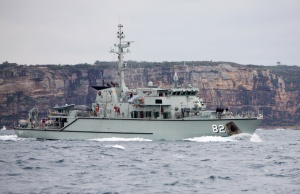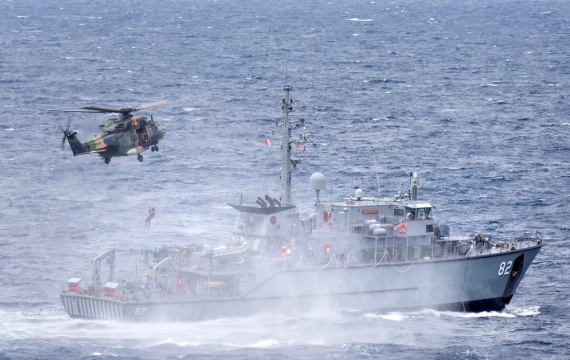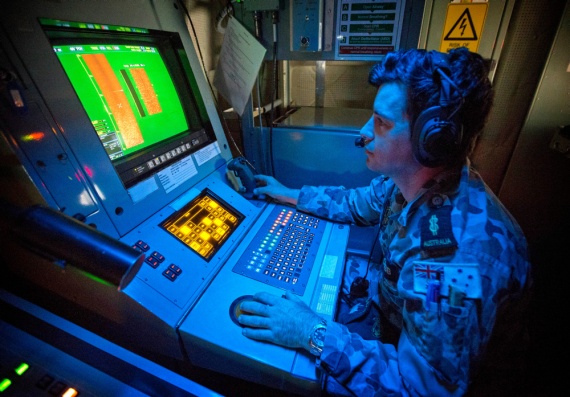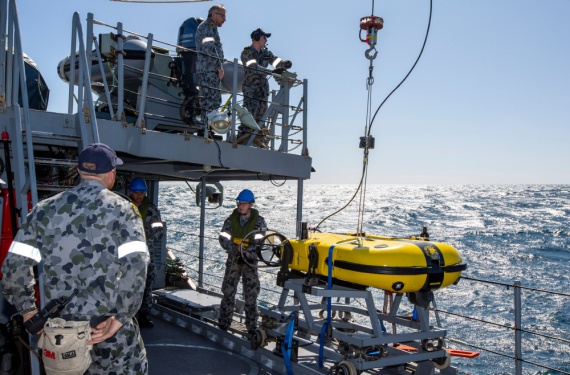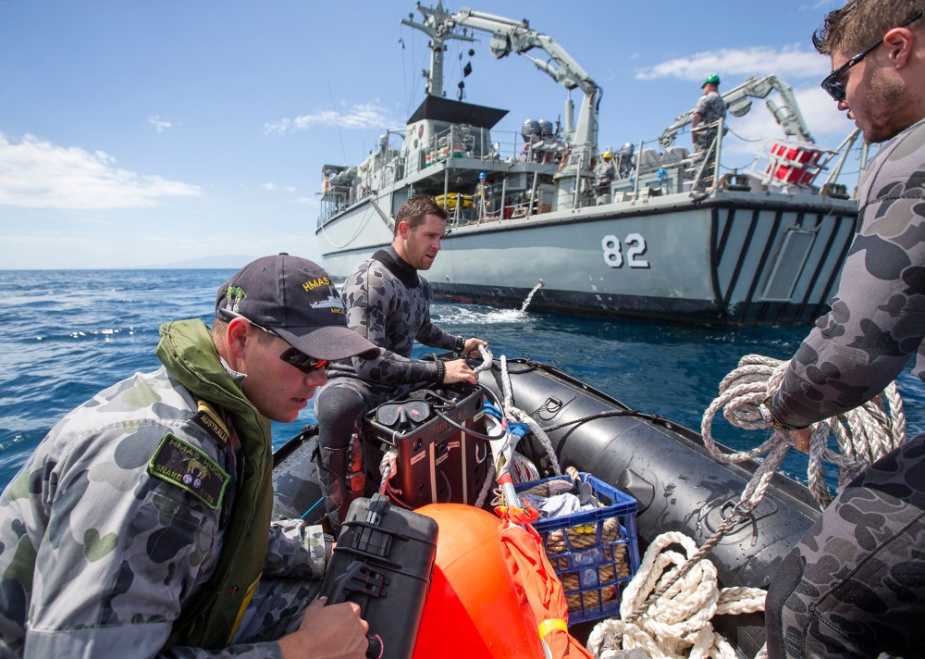HMAS Huon (II)
| Class |
Huon Class |
|---|---|
| Type | |
| Role | Mine Warfare |
| Pennant |
M82 |
| International Callsign |
VLTC |
| Motto |
Stand Fast |
| Home Port | |
| Builder |
ADI Newcastle |
| Launched |
25 July 1997 |
| Commissioned |
15 May 1999 |
| Decommissioned |
30 May 2024 |
| Dimensions & Displacement | |
| Displacement | 732 tonnes |
| Length | 52.5 metres |
| Beam | 9.9 metres |
| Draught | 3 metres |
| Performance | |
| Speed | 14 knots |
| Range | 1,600 nautical miles |
| Complement | |
| Crew | 46 |
| Propulsion | |
| Machinery |
|
| Armament | |
| Guns | 1 x MSI DS 30B 30mm |
| Physical Countermeasures |
|
| Electronic Countermeasures | AWADI Prism |
| Radars | Kelvin Hughes 1007 |
| Sonars | GEC-Marconi Type 2093 |
| Combat Data Systems | GEC-Marconi Nautis 2M |
| Weapon Control Systems | Radamec 1400N optronic surveillance system |
| Awards | |
| Inherited Battle Honours | |
| Resources | |
| News Articles | |
| Image Gallery | |
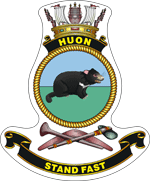
HMAS Huon (II) was the first of six Huon Class Minehunters built for the Royal Australian Navy by Australian Defence Industries, Newcastle, NSW.
The ship commissioned on 15 May 1999 at HMAS Waterhen in Sydney, under the command of Commander Geoffrey Uren. The ceremony was attended by the minister representing the Minister for Defence, Senator Eric Abetz; the Chief of the Defence Force, Admiral Chris Barrie; the Chief of Navy, Vice Admiral Don Chalmers; Maritime Commander Australia, Rear Admiral Chris Ritchie; and the guest of honour, Mrs Betty Norris. Mrs Norris’s husband, Greg Norris, was lord mayor of the Tasmanian local government area of Huon Valley at the time. Huon was at sea just two days after commissioning, conducting exercises off the New South Wales coast.
Huon was the second Australian ship to bear the name and the first of six Huon class minehunter coastal (MHC) vessels commissioned into the Royal Australian Navy. This class of MHC was named after Australian rivers, with the class and Huon itself taking their name from the Tasmanian perennial river that runs for 174 kilometres from the Marsden Range, through Lake Pedder and the picturesque Huon Valley, into the D’Entrecasteux Channel and then the Tasman Sea. HMAS Huon (I) was a River Class Destroyer in commissioned service during the First World War.
The design of the Huon class was based on the Italian Gaeta class minehunter (which was itself a derivative of the Lerici class), with modifications to suit Australian conditions. The Huon class featured a unique hull design made of composite plastic that had no ribs, frames or stiffeners—avoiding local stress points that could separate under shock conditions—and an inherently low magnetic signature, enabling operation in hostile mine environments. For mine countermeasure operations, the ships were fitted with a variable depth sonar, capable of detection ranges in excess of 1,000 metres ahead of the ship, and a pair of electrically powered Bofors Underwater Systems Double Eagle mine disposal vehicles.
Huon participated in her first fleet exercise, Crocodile 99, in Queensland waters in September of its commissioning year, and visited Tasmania in November. There, she paid her first visit to Port Huon, on the south-west coast, and participated in an ‘adoption’ ceremony at nearby Huonville. The ship’s company has exercised its right to Freedom of Entry to the town of Huonville three times since its adoption, most recently in 2017, after six weeks’ deployment in the south-west Pacific. Mrs Norris, who had named Huon back in 1999, met with the company during the celebrations.
Throughout its years of service, Huon participated in several fleet and multi-service exercises: Fleet and Minor War Vessel concentration periods, and exercises Hunter (2001), Tandem Thrust (2001), Dugong (2002, 2004, 2005, 2009), Ocean Protector (2005), Mulgogger (2005, 2012, 2013), Triton Fury (2012), Kakadu (2012), Cassowary (2013), Ocean Raider (2016), Ocean Explorer (2017, 2018), Cuttlefish (2020), Sea Raider (2023) and Talisman Sabre (2023). In July and August 2023, Huon participated in recovery operations following the tragic MRH90 Taipan helicopter crash that claimed the lives of four Australian Defence Force members during Talisman Sabre.
Huon also participated in several multinational exercises overseas, including exercises Flying Fish and Penguin in 2000; mine warfare exercises in 2001, 2004, 2011 and 2018; Exercise Bersama Lima in 2011; and Exercise Hyuga Nada in 2018. Over the course of its commission, the ship conducted exercises alongside units from Brunei, Indonesia, France, Japan, Malaysia, New Zealand, South Korea, Thailand, Timor Leste, the United Kingdom and the United States of America. She visited ports in most of these countries (excluding those in the United States and Europe), as well as in Fiji, New Caledonia, the Philippines, Solomon Islands, Vanuatu and Vietnam. Huon’s north-east Asian deployment in 2018, in company with sister ship HMAS Gascoyne, represented the most northward deployment of any Australian mine warfare vessel.
In February 2004, Huon deployed to Solomon Islands in support of Operation Anode, the Australian Defence Force’s contribution to the Australian-led Regional Assistance Mission to Solomon Islands, intended to assist the Solomon Islands Government in restoring law and order during a period of civil unrest. She arrived in the area of operations on 16 February and spent most of the following five weeks patrolling the waters around the islands.
While conducting exercises in Jervis Bay on 1 February 2005, Huon was struck by lightning. While the ship lost power temporarily, there were no injuries and only minor damage. After a few days alongside at HMAS Creswell to conduct repairs, she was operational again on the morning of 5 February.
In January 2011, Huon’s ship’s company was recalled from Christmas leave to contribute to Operation Queensland Flood Assist, which became the Defence Force’s largest domestic humanitarian relief effort since Cyclone Tracy. After what had already been a month of heavy rain, Cyclone Tasha’s torrential rains over Christmas 2010 exacerbated already widespread flooding, until 75 per cent of the state was affected. Huon arrived in Moreton Bay on the evening of 17 January; she was the first RAN fleet unit to arrive in the region for the recovery and reconstruction phase of the operation. She commenced hydrographic survey operations in the bay the following morning, looking for submerged debris, with several cargo vessels at anchor waiting for the main shipping channel into the bay to be cleared. Huon continued survey operations in the bay and the mouth of the Brisbane River through to the end of the month.
Huon returned to Solomon Islands in August 2012 to participate in events commemorating the seventieth anniversaries of the battles of Guadalcanal and Savo Island. While in the region, she also conducted patrols in support of Operation Solania, the Defence Force’s contribution to multinational maritime surveillance in the Pacific region.
In October 2013, Huon played a central role in the International Fleet Review, commemorating the hundredth anniversary of the arrival of the first RAN fleet unit. Huon formed part of the ‘Magnificent Seven’—those ships representing the original seven ships of the fleet unit that entered Sydney Harbour in 1913. Huon took on the role of the torpedo boat destroyer HMAS Yarra (I). The ship remained alongside at HMAS Waterhen, on the lower north shore, for a week while the ship’s company continued to participate in fleet review events, including the massed naval parade that marched through the streets of Sydney on 9 October.
In 2016 and 2019, Huon supported Operation Render Safe, the ADF operation to safely dispose of remnant Second World War–era explosives in the South Pacific. With other Australian and other navy ships, Huon searched various areas to determine presence or absence of unexploded ordnance to direct neutralisation by clearance diving teams.
The outbreak of the COVID-19 pandemic in 2000 curtailed Huon’s operations, though internal training continued over the period. Several members of the ship’s company were assigned to Operation COVID-19 Assist, contributing to the whole-of-government response to the pandemic with customised support for state and territory authorities.
In addition to her nominal mine warfare role, Huon has also conducted occasional hydrographic operations in Australian waters, including in the Great Barrier Reef and around Rottnest Island, Port Philip Bay and Moreton Bay.
Huon was awarded the Duke of Gloucester’s Cup in 2013, as the RAN unit displaying the highest level of overall proficiency that year.
| Date Commenced | Commanding Officer |
| 15 May 1999 | CMDR GD Uren |
| 20 April 2000 | CMDR JR Griffith |
| 7 December 2001 | LCDR BW Jones |
| 18 December 2003 | LCDR KJM Dillon |
| 28 January 2004 | LCDR MJ Treeby |
| 31 March 2006 | Deactivated |
| 1 June 2006 | LCDR PW Koerber |
From September 2006 to November 2010, Huon employed a multi-crewing system. During that period, the following officers commanded the ship at various times:
| Crew | Commanding Officer |
| MHC Crew One | LCDR DWC Clelland |
| Hunter Two | LCDR ST Dunne |
| Hunter One | LCDR BA Esler |
| Hunter Two, MHC Crew Two | LCDR MP Gough |
| Hunter One | LCDR DJ Griffiths |
| Hunter Two | LCDR PW Koerber |
| Hunter Three | CMDR ML Maley |
| Hunter One | LCDR EM Moore |
| Hunter Three | CMDR DP Schopen |
| MHC Crew Three | LCDR AMR Stevens |
The MHC multi-crewing model ceased in November 2010, though a flexible crewing model remained in place.
| Date | Commanding Officer |
| 29 November 2010 | LCDR AMR Stevens |
| 17 December 2010 | LCDR JM Relyea |
| 26 March 2012 | LEUT R Kelly |
| 1 April 2012 | LCDR JM Relyea |
| 17 April 2012 | LCDR A Duff |
| 29 April 2012 | LCDR JM Relyea |
| 8 May 2012 | LCDR JS Hutchison |
| 22 May 2014 | LCDR RA Caton PSM |
| 1 January 2015 | CMDR RA Caton PSM |
| 7 December 2015 | LCDR JJ Mullen |
| 18 January 2018 | LCDR A Parton |
| LCDR CA Cockerill | |
| 11 January 2019 | LEUT GV Crane |
| LCDR CA Cockerill | |
| LCDR GV Crane | |
| LCDR RK Short | |
| LCDR BT Mulraney | |
| 29 November 2023 | LCDR TD Baird |
Huon decommissioned on 30 May 2024.

